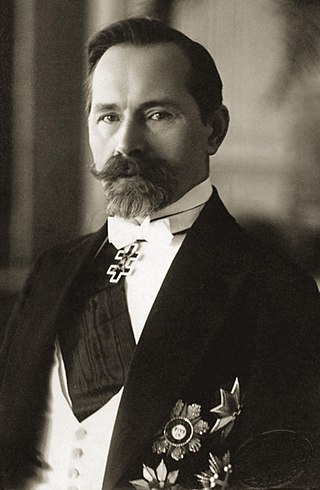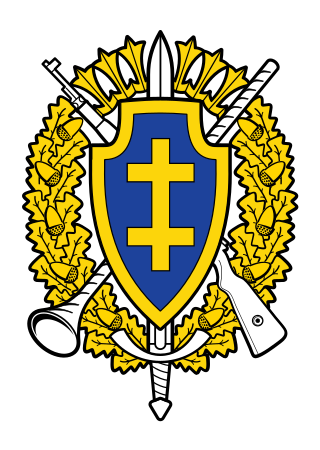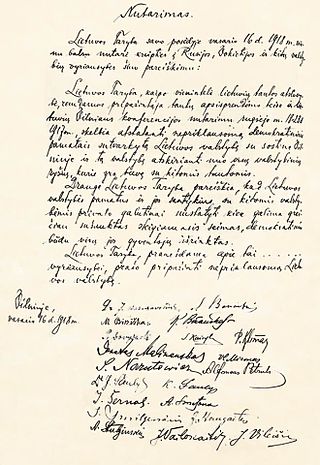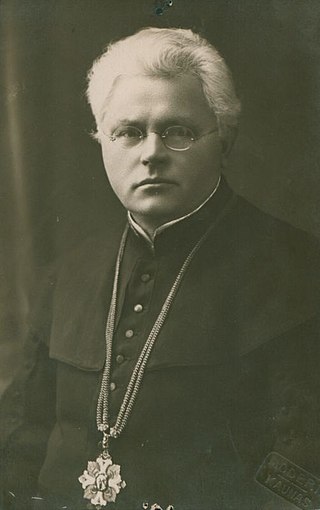
Antanas Smetona was a Lithuanian intellectual and journalist and the first President of Lithuania from 1919 to 1920 and again from 1926 to 1940, before its occupation by the Soviet Union. He was one of the most important Lithuanian political figures between World War I and World War II, and was one of the most prominent ideologists of nationalism in Lithuania.

The Lithuanian Riflemen's Union, also referred to as Šauliai, is a paramilitary non-profit organisation supported by the Government of Lithuania. Their activities are in three main areas: military training, sport, and culture.
Lietuvos žinios was a daily newspaper in Lithuania. Established in Vilnius in 1909, it was a liberal newspaper representing the Lithuanian Democratic Party. Even though its publication was interrupted by World War I and Soviet occupation of Lithuania, Lietuvos žinios billed itself as the oldest newspaper in Lithuania.

The Act of Independence of Lithuania or the Act of February 16, also the Lithuanian Resolution on Independence, was signed by the Council of Lithuania on February 16, 1918, proclaiming the restoration of an independent State of Lithuania, governed by democratic principles, with Vilnius as its capital. The Act was signed by all twenty representatives of the Council, which was chaired by Jonas Basanavičius. The Act of February 16 was the result of a series of resolutions on the issue, including one issued by the Vilnius Conference and the Act of January 8. The path to the Act was long and complex because the German Empire exerted pressure on the Council to form an alliance. The Council had to carefully maneuver between the Germans, whose troops were present in Lithuania, and the demands of the Lithuanian people.

Juozas Tumas also known by the pen name Vaižgantas was a Lithuanian Roman Catholic priest and an activist during the Lithuanian National Revival. He was a prolific writer, editor of nine periodicals, university professor, and member of numerous societies and organizations. His most notable works of fiction include the novel Pragiedruliai and the narrative Dėdės ir dėdienės about the ordinary village folk.

The Ministry for Belarusian Affairs was a short-lived interwar Lithuanian ministry. It was established in December 1918 to gain support of Belarusians in international negotiations over the borders of the newly independent Lithuania. However, the Lithuanian government did not support Belarusian autonomy and the ministry effectively competed with the Rada of the Belarusian Democratic Republic. Activities of the ministry were limited to publication of several books and two periodicals and other cultural work. The ministry was officially closed in January 1924.
The Lithuanian conferences during World War I refer to ten conferences held by Lithuanian activists during World War I in Switzerland and Sweden. They articulated the vision of independent Lithuanian state free of Russian, German, and Polish influence and as such were an important step towards the Act of Independence of Lithuania in February 1918.
Lietuvos ūkininkas was a weekly Lithuanian-language newspaper published between 1905 and 1940. It was published by and reflected the political views of the Lithuanian Democratic Party, Peasant Union, and Lithuanian Peasant Popular Union. Its printing and daily operations were managed by its long-time publisher Felicija Bortkevičienė. It was a liberal publication geared towards the wider audience of less educated farmers and peasants. In 1933, its circulation was 15,000 copies. When Lithuania was occupied by the Soviet Union in 1940, the newspaper was nationalized and replaced by Valstiečių laikraštis.
Sovetskaya Litva was a Russian-language daily newspaper published in the Lithuanian SSR. In tandem with the Lithuanian-language Tiesa, it was the official newspaper of the Communist Party of Lithuania, the Supreme Soviet of the Lithuanian SSR, and the Council of Ministers of the Lithuanian SSR. After the restoration of Lithuania's independence in 1990, the newspaper became an independent daily under the name Echo Litvy. Its circulation was 79,000 copies in 1981, 26,000 copies in 1993, and 12,000 copies in 1997. It discontinued publication in 2001 due to financial difficulties.
Viltis was a Lithuanian-language newspaper published in Vilnius in 1907–1915 and 1991–1994. The newspapers was established in October 1907 by Antanas Smetona and Juozas Tumas-Vaižgantas. It promoted unity among Lithuanians attempting to bring together conservative Catholic clergy and more liberal intelligentsia. The newspaper concentrated on cultural matters as opposed to politics or news reports. It was supported by the clergy, but it was not a religious newspaper. Eventually, the clergy grew dissatisfied with the secular and moderate tone and Smetona left in 1913 to establish a separate newspaper Vairas. The intellectuals around Viltis became known as viltininkai and formed an early embryo of the Lithuanian Nationalist Union, the ruling party in Lithuania in 1926–1940. Viltis was discontinued due to World War I. It was briefly resurrected in the early 1990s by the Lithuanian Nationalist Union.
Vairas was a Lithuanian-language political and cultural newspaper published by Antanas Smetona and the Lithuanian Nationalist Union, the ruling party in Lithuania in 1926–1940. It was published three separate times. Vairas was first established in January 1914 when Smetona departed Viltis; it was discontinued due to World War I. The newspaper was briefly revived in September 1923 when Smetona and Augustinas Voldemaras harshly criticized their political opponents and the Lithuanian government. Due to anti-government rhetoric, their newspapers were closed by state censors one after another, but they would quickly establish a new newspaper under a new title. Vairas was closed in February 1924. The newspaper was reestablished as a cultural magazine in 1929 with the backing of the authoritarian regime of Smetona. In 1939, it became a weekly political magazine that pushed an agenda of radical nationalism and openly sympathized with National Socialism. The magazine was discontinued after the Soviet occupation of Lithuania in June 1940.

Rapolas Skipitis was a Lithuanian attorney and politician. In 1920–1922, he was Minister of the Interior and was later elected to the Second and Third Seimas. After the 1926 coup d'état, he chaired the Lithuanian Riflemen's Union (1927–1928), Society for the Support of Lithuanians Abroad (1932–1940), and several other Lithuanian organizations. He also edited several newspapers, including Ūkininko balsas (1925–1928), Trimitas (1927–1928), Namų savininkas and Pasaulio lietuvis (1937–1940). At the start of World War II, he retreated to Germany and joined the Lithuanian Activist Front. He was reserved the seat of Minister of Foreign Affairs in the Provisional Government of Lithuania. After the war, he settled in Chicago where he was active in Lithuanian American cultural life.
Tauta was a Lithuanian-language newspaper published by the Party of National Progress in Kaunas, Lithuania from 19 November 1919 to 5 November 1920. It was a four-page newspaper published once or twice a week. In total, 65 issues appeared.

Mūsų senovė was a Lithuanian-language academic magazine published in Kaunas, Lithuania in 1921–1922 and in 1937–1940. It was the first attempt to publish a periodical dedicated to the study of the history in Lithuanian. It was published irregularly and mostly dealt with the materials and topics related to the Lithuanian National Revival and the Lithuanian press ban. In total, 10 issues appeared.

The Union for the Liberation of Vilnius was an organization established in 1925 to support Lithuanian territorial claims to Vilnius Region then part of the Second Polish Republic. With 27,000 members and 600,000 supporters in 1937, it was one of the most popular organizations in interwar Lithuania. Its main goal was to mobilize the entire Lithuanian nation for cultural and educational work. It established an unofficial but highly popular national mourning day on 9 October. It organized numerous events, such as lectures and concerts, to promote the idea of Vilnius as an integral part of the Lithuanian national identity – the historical capital of Lithuania that was unjustly occupied by Poland, though the city itself had a minuscule Lithuanian population. It also developed a coherent narrative of suffering brothers Lithuanians under the oppressive Polish regime, giving Lithuanians a common enemy. The union promoted emotional, almost cult-like, national attachment to Vilnius. The union was disestablished after the Polish ultimatum in March 1938.

Eduards Volters (1856–1941) was a linguist, ethnographer, archaeologist who studied the Baltic languages and culture. He was a long-time professor at the Saint Petersburg University (1886–1918) and Vytautas Magnus University (1922–1934).

Bronius Kazys Balutis (1880–1967) was a Lithuanian diplomat. He worked at the Ministry of Foreign Affairs of Lithuania in 1919–1928 and was involved in many of the major international negotiations of the period. He was the Lithuanian envoy to United States (1928–1934) and to the United Kingdom (1934–1967).
The coup d'état attempt in 1934 was an attempt by voldemarininkai, supporters of the former Prime Minister Augustinas Voldemaras, to overthrow the government of President Antanas Smetona. While voldemarininkai planned several coups against the government, this coup was the largest and most threatening.

The Lithuanian Sanitary Aid Society was a Lithuanian society established in 1918 to provide medical care to refugees during World War I. First established in Minsk, the society purchased hospital equipment of a war hospital and relocated to Vilnius in July 1918. There it opened a hospital and continued to operate it until around 1941. Over the years, the hospital treated a total of about 300,000 patients. It was a charitable society, thus many of its treatments were provided at low cost or for free. After Vilnius incorporation into the Second Polish Republic, the society and the hospital were one of a few Lithuanian institutions active in Vilnius Region. The society and the hospital were headed by Danielius Alseika and, after his death, by Vytautas Legeika.
Vilniaus rytojus was a Lithuanian-language newspaper published in Vilnius between 1928 and 1937. Published by the Provisional Committee of Vilnius Lithuanians, the newspaper defended the rights of Lithuanians in Vilnius Region which was part of the Second Polish Republic but was claimed by the interwar Lithuania. Due to these tensions, the newspaper was subject to strict censorship by the Polish authorities and was forcibly closed in October 1937. It was the longest running Lithuanian periodical in the Vilnius Region.











